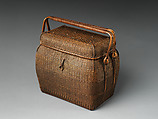Basket for Transporting Sencha Tea-Ceremony Utensils (Chakago or Teiran)
Hayakawa Shōkosai I Japanese
Not on view
Shōkosai is believed to be the first master craftsman of baskets to sign his compositions, a custom probably inspired by Western artists amid the Meiji-period modernization of the Japanese decorative arts. The signature would have also indicated that his Chinese-inspired karamono works were actually made by a Japanese master. Shōkosai concentrated for the most part on making tea-ceremony utensils (primarily using rattan), reflecting the needs of the literati and others associated with the period’s thriving sencha tea culture. He came to prominence in 1877 when one of his sencha works—a lidded basket with a handle, intended to carry a tea set to an outdoor event—received the Phoenix Prize at the first Domestic Industrial Exposition held in Tokyo.
Due to rights restrictions, this image cannot be enlarged, viewed at full screen, or downloaded.
This artwork is meant to be viewed from right to left. Scroll left to view more.




